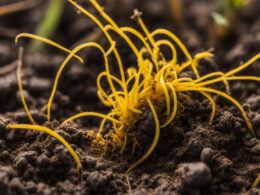If you’re a fan of gardening and landscaping, you may have come across the trumpet vine. With its vibrant colors and trumpet-shaped flowers, it’s a popular choice for adding beauty to your outdoor spaces. But have you ever wondered if the trumpet vine is actually native to the United States?
In this article, we’ll explore the history and origins of the trumpet vine, from its native range to its introduction to North America. We’ll also discuss the plant’s potential as an invasive species and provide tips for cultivating trumpet vine in your own garden. So let’s dive in and discover the truth about this stunning plant!
Post Summary:
- The trumpet vine is a popular plant for gardening and landscaping.
- We’ll explore the history and origins of the trumpet vine in this article.
- We’ll discuss the potential of the trumpet vine as an invasive species.
- We’ll provide tips for cultivating trumpet vine in your garden.
Understanding Trumpet Vine
Trumpet vine, also known as Campsis radicans, is a beautiful flowering plant that is native to the southeastern United States. It is well-loved for its large trumpet-shaped flowers that range in color from bright orange to deep red, and its ability to climb up walls, trellises, and fences.
Identifying trumpet vine is relatively easy due to its distinctive characteristics. Its leaves are shiny, dark green and arranged in an opposite pattern along the vine. The plant produces clusters of trumpet-shaped flowers that usually bloom in the summer months. Its fruit is a long, narrow pod that contains flat seeds.
Trumpet Vine Characteristics
Trumpet vine is a perennial plant that can grow up to 30 feet tall, typically reaching about 10-20 feet in height. It has a woody stem that becomes thicker as the plant matures. It flowers from June to September, with each flower lasting only a few days. The plant prefers full sun to light shade and moist, well-drained soils.
The trumpet vine is a vigorous and fast-growing species that can become invasive if not managed properly. It is important to choose the right location to plant, and to be aware of its growth habits.
Trumpet Vine Identification
Trumpet vine can be identified by its large, funnel-shaped flowers and its thick, woody vines. The vines can climb up walls and structures using aerial rootlets that attach and anchor the plant in place. Its leaves are a glossy green color and are elongated and pointed. The plant produces clumps of flowers that generally have a similar color and shape.
When identifying trumpet vine, be sure not to confuse it with other similar plants, such as poison ivy or Virginia creeper. Trumpet vine has a woody stem and trumpet-shaped flowers, while poison ivy has a more delicate stem and vine-like leaves and Virginia creeper has five leaflets on each leaf.
Native Range of Trumpet Vine
If you’re wondering where trumpet vine is from, you’ll be interested to know that its native range is quite extensive. The plant is indigenous to the southeastern United States, including Florida, Georgia, and Mississippi. It can also be found in other regions of the country, including the Midwest.
The scientific name for trumpet vine is Campsis radicans, and it belongs to the Bignoniaceae family of plants. The common name refers to the plant’s trumpet-shaped flowers, which are typically orange, red, or yellow.
Trumpet vine is a woody vine that can grow up to 30 feet long, and it’s known for its fast-growing and aggressive nature. While it’s a beautiful plant that can provide great benefits, it’s also important to be mindful of its potential to become invasive in certain areas.
Introduction of Trumpet Vine to North America
Trumpet vine (Campsis radicans) is a deciduous vine that was introduced to North America by early European settlers. The exact date and origin of the plant’s introduction are unclear, but it is believed to have been first introduced to Virginia and gradually spread throughout the continent.
The plant’s ability to climb and spread quickly made it a popular choice for ornamental purposes in gardens and landscaping. However, its aggressive growth and ability to overtake native vegetation has also led to concerns about its invasive nature.
The History of Trumpet Vine’s Introduction
“Campsis radicans was first introduced into horticulture in 1640 through the efforts of botanist John Tradescant. Its cultivation and popularity in American gardens was fueled by the famous garden writer and designer, Andrew Jackson Downing, who encouraged the planting of native species. “
While the exact date and origin of trumpet vine’s introduction to North America is uncertain, it is known that the plant was present in Virginia by the early 1600s. Its popularity as an ornamental plant quickly spread, and it was soon cultivated in gardens across the continent.
Trumpet vine’s ability to thrive in a variety of growing conditions and climb to impressive heights made it particularly appealing. Its striking trumpet-shaped flowers and vibrant colors also contributed to its popularity.
The Spread of Trumpet Vine
As trumpet vine became more widely cultivated and used in landscaping, its spread throughout North America became inevitable. The plant’s ability to produce prolific seeds and spread via underground runners made it particularly invasive in some areas, causing concern among conservationists and gardeners alike.
Today, trumpet vine can be found throughout the United States, from the eastern coast to the central and western regions. Its invasive nature, coupled with its popularity in gardens and landscaping, has made managing the plant’s growth and spread an ongoing challenge.
Trumpet Vine as an Invasive Species
If you’re considering planting trumpet vine in your yard, it is important to be aware of its potential invasiveness. While trumpet vine can be a beautiful addition to a garden, it can also quickly spread and outcompete other vegetation in the area. This can create problems for the local ecosystem.
Trumpet vine is known for its rapid growth and ability to climb high into trees and structures. This makes it difficult to control once it becomes established in an area. It can also spread through underground runners, making it difficult to completely remove.
If you do decide to plant trumpet vine, it is important to take measures to control its growth and prevent it from spreading beyond the desired area. This can include regular pruning and removal of seed pods. In some cases, chemical control may be necessary to manage the plant.
If you are concerned about the potential invasiveness of trumpet vine, consider choosing a native alternative that provides similar benefits. This can help support the local ecosystem and prevent the spread of non-native plants.
Cultivating Trumpet Vine in Your Garden
If you’re considering cultivating trumpet vine in your garden, there are a few things you need to know. This plant is easy to grow, but it can quickly become invasive if not properly managed.
Suitable Growing Conditions
Trumpet vine thrives in full sun and well-drained soil. Make sure to plant it in an area with plenty of room to climb, such as a trellis or fence. Water regularly during the growing season, but be careful not to overwater.
Pruning
To prevent trumpet vine from becoming too invasive, it’s essential to prune it regularly. This will help keep it under control and encourage more flowering. Prune in late winter or early spring before new growth begins.
Propagation Methods
Trumpet vine can be propagated by seed or cuttings. To propagate by seed, collect mature seed pods in the fall and plant them in the ground or in pots in late winter. To propagate by cuttings, take 6-8 inch cuttings from new growth in late spring or early summer and root them in potting soil.
Final Thoughts
Trumpet vine can add a pop of color and interest to any garden, but it’s important to be mindful of its potential to become invasive. With proper care and management, you can enjoy the beauty of this plant without it taking over your garden.
Trumpet Vine in Landscaping and Wildlife Gardens
If you’re looking to add some color and life to your landscaping or wildlife garden, trumpet vine may be just the plant you need. With its beautiful trumpet-shaped flowers and ability to attract pollinators and beneficial insects, trumpet vine can enhance both the aesthetic appeal and ecological value of your outdoor space.
Trumpet vine is a fast-growing and hardy plant that can thrive in a variety of soil types and light conditions. It can be trained to climb fences, trellises, and walls, making it a versatile addition to any garden. It is also a great plant for attracting hummingbirds, bees, and butterflies, which are vital for pollinating other plants in the garden.
However, it is important to note that trumpet vine can be invasive and may require proper maintenance to prevent it from taking over your garden. Regular pruning and monitoring can help control the growth of the plant and prevent it from spreading too rapidly.
Using Trumpet Vine in Landscaping
Trumpet vine can be used in a variety of landscaping settings, including as a climber for walls or as a ground cover for large areas. It can also be trained to grow over pergolas or trellises, creating a beautiful and natural canopy.
When selecting a location for your trumpet vine, consider the amount of sunlight and space available for the plant to grow. It is best planted in a sunny location with well-draining soil to encourage healthy growth.
Trumpet Vine and Wildlife
In addition to its aesthetic value, trumpet vine can also attract a variety of wildlife to your garden. The plant’s bright flowers and sweet nectar can draw in hummingbirds, while the foliage provides a sanctuary for insects and small animals.
However, it is important to note that trumpet vine can also be toxic to some animals if ingested, so it is important to keep an eye on your pets and other wildlife in your garden.
Overall, incorporating trumpet vine into your landscaping and wildlife garden can be a great way to enhance the beauty and ecological value of your outdoor space. With proper maintenance and care, this plant can provide a stunning backdrop for your garden and attract a variety of pollinators and beneficial insects.
Conclusion
Now that you know all about trumpet vine, you can appreciate the beauty of this plant while being mindful of its potential invasiveness. Although trumpet vine is not native to North America, it has become a common sight in gardens and natural areas throughout the continent.
If you want to grow trumpet vine in your garden, remember to provide suitable growing conditions and keep an eye on its growth. If left unchecked, trumpet vine can quickly spread and become a problem. But with proper care and management, this plant can bring joy and beauty to your landscape.
And if you’re looking to attract pollinators and wildlife to your garden, consider planting trumpet vine. Its trumpet-shaped flowers are a favorite of hummingbirds, bees, and butterflies, and its dense foliage can provide cover for small animals.
So go ahead and enjoy trumpet vine in your garden, but remember to be a responsible gardener and keep an eye on its potential to spread.
Are Trumpet Vines Harmful to the Environment or Native Species?
Trumpet vine toxicity facts are important to consider when planting these vines. While they are beautiful and attract hummingbirds, they can be harmful to the environment and native species. The vines can spread aggressively and crowd out other plants, impacting the local ecosystem. It’s essential to weigh the benefits against the potential harm.
FAQ
Q: Is trumpet vine a native plant?
A: Yes, trumpet vine is native to North America.
Q: What are the characteristics of trumpet vine?
A: Trumpet vine is known for its trumpet-shaped flowers, vibrant colors, and climbing nature.
Q: Where is trumpet vine originally from?
A: Trumpet vine is native to North America, specifically the southeastern United States.
Q: How was trumpet vine introduced to North America?
A: Trumpet vine was introduced to North America by early European settlers.
Q: Is trumpet vine considered an invasive species?
A: Yes, trumpet vine can be invasive and overtake native vegetation if not properly managed.
Q: How can I control trumpet vine as an invasive species?
A: Controlling trumpet vine as an invasive species can be done through regular pruning and monitoring of its growth.
Q: How do I cultivate trumpet vine in my garden?
A: To cultivate trumpet vine in your garden, provide it with suitable growing conditions, regular pruning, and propagate it through seeds or cuttings.
Q: Can trumpet vine be used in landscaping and wildlife gardens?
A: Yes, trumpet vine can be used in landscaping to add aesthetic appeal and attract pollinators, birds, and beneficial insects to wildlife gardens.
Q: What should I keep in mind about trumpet vine?
A: While trumpet vine is beautiful, it is important to be mindful of its potential invasiveness and take necessary steps to control its spread.









